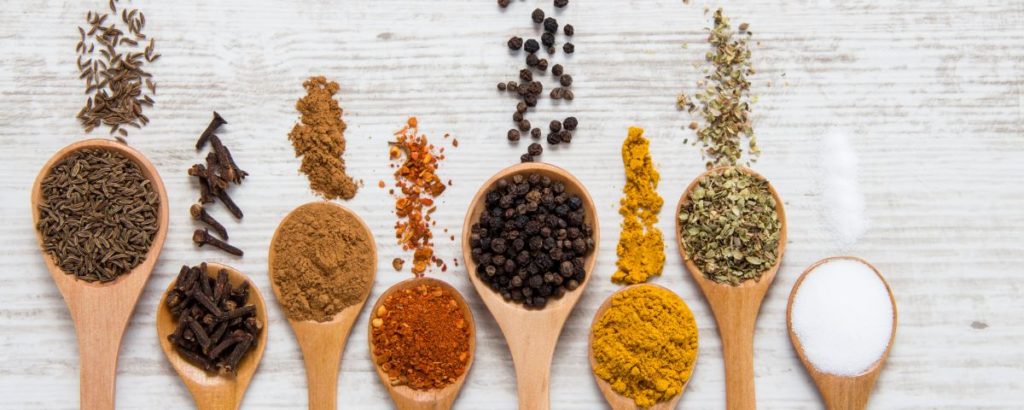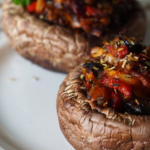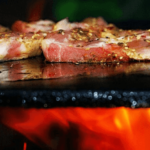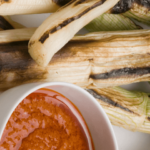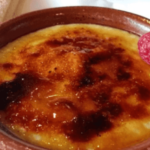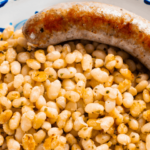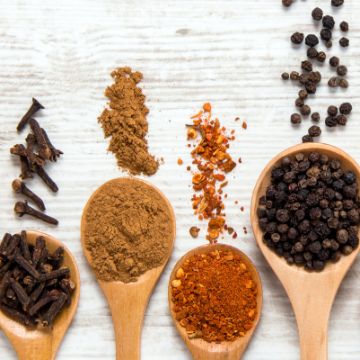
Traditional Spanish Herbs and Spices List
A GUIDE TO HERBS AND SPICES IN SPAIN
The other day I was on a tapas tour with a couple. The lady was from London and she told me British food isn’t too flavorful because in the old times they couldn’t grow many herbs and spices there. I thought it was quite curious!
And that led us to discuss how Spanish cooking is full of flavor, but it’s not as exotic or hot spicy as Mexican or Asian in general. We rely mostly on Mediterranean herbs and local seasonings, but the use of spices is moderate – just to add a touch, not to be the star of the dish. Of course, our conversation gave me the idea for today’s post.
So let’s start with the basics: what’s the difference between seasonings, herbs and spices? Well, seasonings seems to be a generic term to refer to any ingredient that is added to food to enhance its flavor. So both spices and herbs are seasonings.
Then, herbs are fresh plants (that ideally need to be kept refrigerated or on a vase with water, although you also see them used dry), and they add a subtle flavor to foods. They can sometimes be used as garnish. Instead, spices are dry seeds, fruits, roots or stalks that are stored in the pantry and are rarely used as garnish. Their flavor is stronger.
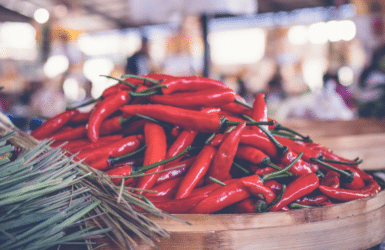
Are you curious to know which seasonings, herbs and spices are used in Spain? Keep reading to discover what are the most common of them used in the Spanish cooking, and that are staples in any local kitchen.
Common Spanish spices
1
Guindilla - Cayenne Pepper
In Spain we call guindilla all fruits of the Capsicum plant that are spicy hot. The sweet varieties are called “pimiento” instead, even if it’s the same plant. Most of the time we use “Capsicum Annun” – Cayenne Pepper, which is not as hot as jalapeños or habaneros.
You’ll see guindillas used in Spanish dishes such as gambas al ajillo (garlicky shrimp), sardinas en escabeche (marinated sardines) or fish “a la bilbaina” style. Another popular type of guindilla is the piparra, a green basque variety that is served pickled as an appetizer.
2
Canela - Cinnamon
You’ll find it in traditional sweets such as arroz con leche (rice pudding), torrijas (Spanish French toasts), natillas (custard), crema catalana (Catalan creme brulee), leche merengada (cinnamon milkshake).
And while not very common, there’s some savoury recipes that also carry it such as the morcilla (blood sausage) from Aragon And it can also be added to Catalan sweet and sour recipes such as duck with pears or bacalla a la mel (codfish with honey), to squid meatballs or to pork sirloin in cinnamon sauce.
3
Clavo - Clove
It’s also traditionally used in offal recipes such as callos (tripe), oxtail, pig trotters, as well as meat stews such as Toledo-style partridge or baked pork knuckle. In desserts you can see it added to cookies or as an interesting addition to rice pudding.
4
Nuez Moscada - Nutmeg
In Spain is mostly used to make bechamel (white) sauce, which is indeed a French sauce but because of its proximity, the French cooking has highly influenced the Spanish and Catalan cuisine.
Cannelloni with bechamel are a typical dish served in Catalonia on special holydays. And bechamel is also the base of croquettes, a very popular Spanish tapa. The Basques add nutmeg to their brandada (codfish paste). And Andalusians incorporate it to their meat with tomato sauce.
5
Nyora - Nora Pepper
In Catalonia, Valencia and Murcia is an essential ingredient of the base of many rice dishes. It’s also used in sauces such as the Catalan romesco sauce or the pericana from Alcoy (Alicante). And in Cartagena they add it to their traditional Caldero (fish and rice dish typical from the area).
6
Pimienta - Peppercorns
Pepper is a key ingredient of most escabeche marinades, and it also adds a touch of heat to callos (tripe), patatas “a lo pobre” (potatoes with onion, garlic, pepper and cayenne) and a myriad of meat dishes such as rabbit, pork, chicken or veal. In the Summer you can also see strawberries sautéed with rum and pepper.
7
Pimentón - Paprika
Christopher Columbus is said to have brought it back from America and offered it to the Catholic Monarchs in the Monastery of Guadalupe, then the monks sent it to other monasteries of their order around Spain.
The pimentón from La Vera and from Caldeleda are dried over oak wood smoke, what gives it a characteristic smoked flavour. It can be sweet, hot, or sweet and sour.
It is a key ingredient of many cured meats: chorizo, chistorra, sobrasada… It is also sprinkled over boiled octopus (pulpo a la gallega), or over baked potatoes. It’s also part of essential recipes such as cocido madrileno (Madrid-style stew), garlic soup, callos, migas (a Spanish main course made with old bread)… It goes also on escabeche marinades and spicy sauces such as salsa brava and mojo picón.
8
Azafrán - Saffron
You need 250,000 saffron blossoms to produce a kilo of saffron. And that explains why it’s so expensive: from each Crocus Sativus bulb grow only 1 to 3 flowers, and each flower gives only 3 red threads, which is what’s used to cook.
The most famous use of saffron in the Spanish cuisine is paella, to which it confers it’s characteristic yellow color. But it’s also used in other rice dishes, in cazón in adobo (Andalusian fried and marinated dogfish), fabes con almejas (beans with clams from Asturias), pepitoria meats (with hardboiled egg yolk and grounded almonds)…
It is also used in desserts such as menjar blanc (almond custard), baked peaches, saffron ring-shaped cookies, or to give a touch of color to rice puddings and creme brulee.
Traditional Spanish herbs
9
Laurel - Laurel or Bay Leaf
It goes on any stew, pot, marinade you can think of. Its digestives effects make it perfect to go with beans and lentils. And it also adds a lovely touch added to the water to cook rice or pasta.
10
Oregano
In Spain oregano is often added to tomato sauce, and it’s also an ingredient of many escabeche and adobo marinades. It’s also added to herb mixes for baked meats, or for backed potatoes, caldereta fish pots…
11
Perejil - Parsley
It looks like parsley soup was a popular dish among the Jewish community in the Middle Ages. When they were expulsed from Spain in 1492, Christians started giving parsley away because “just like the Jewish that ate it”, it had no value…
How sad… Well, at least people aren’t giving it away for free for that reason, but because it’s so easy to grow and requires little care… Many locals grow parsley in their patios so they can use it in their kitchens.
Parsley is a key ingredient of pollo al ajilllo (fried chicken with garlic), it’s sprinkled over grilled squid, over sautée mushrooms. It is also often used as a garnish to decorate fried calamari rings, as a final touch to veal fricando stew… You can even make a delicious omelet just with egg, parsley and caramelized onion or garlic!
12
Romero - Rosemary
It’s hard to list a few traditional recipes that incorporate it, because there are so many: with chicken, with rabbit, with pork, over baked potatoes… It’s often used to aromatize olive oil or to decorate rice dishes and paella.
13
Tomillo - Thyme
In Catalonia, where it is called “farigola“, there’s a soup that is basically water, bread, egg and thyme. In the rest of Spain it’s used for many adobo and escabeche recipes. It is also added to lentil or meat stews, baked fish or chicken, rice dishes, baked potatoes…
14
Salvia - Sage
15
Mejorana - Marjoram
This other Mediterranean herb from the same family of oregano is also occasionally used in the Spanish cuisine. You can see it in action in Malaga-style clams, Catalan green peas, Majorcan Escudella bean pot, baked rabbit…
List of additional Spanish seasonings and ingredients
16
Adobo
Adobo is a Spanish marinade used to preserve and enhance the flavor of meats and fish, as well as some vegetables such as eggplant. Its main ingredients are pimentón, oregano, salt, garlic, vinegar, and other Spanish herbs depending on the recipe.
17
Paella seasoning
While a good cook will prefer to add Spanish herbs and spices to paella separately, the truth is that paella takes hours to prepare and often it’s easier to use a paella seasoning mix that is ready to use. It’s no shame, and many Spaniards do it at home.
They usually contain saffron (avoid the brands that use artificial colouring, turmeric or curry instead), pimentón, nyora, rosemary, garlic powder and sometimes also black or white pepper, thyme, marjoram, clove…
18
Picada
19
Limón - Lemon
Lemon, never lime, is probably the most common citrus in Spain, grown in Andalusia, Murcia and the Valencia region. It’s main use is as a dressing over pretty much anything: fried, seafood, fish, salads, paella and other rice dishes, baked artichokes… even potato chips and coffee!
It’s also often used in desserts and sweets: cookies, sponge cakes, lemon sherbets, lemonades… And did you know the leaves of lemon tree are also used to flavor Murcia paparajotes? They are a traditional dessert similar to French toast.
20
Ajo - Garlic
White and purple garlic are added to a myriad of savory recipes to add a touch of heat, but often it’s the star of the dish, too. Look at “al ajillo” mushroom, shrimp or chicken recipes, where the main ingredient is fried in lots of olive oil, minced garlic and parsley. Fresh minced garlic and parsley are also often sprinkled over grilled seafood or mushrooms.
Alioli sauce is basically olive oil and garlic grounded until they become a thick paste. There’s also the refreshing ajoblanco Summer soup or the warming sopa de ajo or sopa castellana (garlic soup). There’s even olives stuffed with garlic!
21
Sal - Salt
There’s many salt lakes along the Spanish coast: Janubio and Fuencaliente in the Canary Islands, Es trenc, Ibiza and Formentera in the Balearic Islands, Torrevieja and Santa Pola in the Valencia region, the Ebro river Delta in Catalonia, Isla Cristina, Chiclana and Cabo de Gata in Andalusia, San Pedro del Pinatar in Murcia, Añana in the Basque Country…
The salt lakes of Oro in Navarra are a rarity, because they are the only inland salted spring in Europe. And Cardona near Barcelona was a rock salt mine that stopped its production in 1990 and now is open for visitors.
22
Aceite de Oliva - Olive Oil
And it is also used to preserve meets, canned seafood and cheese. Of course, it has to be AOVE (Aceite de Olive Virgen Extra, extra virgin olive oil). There’s 32 DOP (protected origin denomination areas) and 2 IGP (protected geographical indications). There’s over 200 types of olives used to make olive oil, and a variety of categories that rank the quality of oil.
23
Vinagre de Jerez - Sherry vinegar
Red vinegar is the other essential dressing in Spain, used in emblematic recipes such as gazpacho, as well as many escabeche marinades, and preserved anchovies (boquerones), vegetable and mushroom pickles… It can also be sprinkled over salad, or even strawberries for a flavorful dessert.
Sherry vinegar is to Spain what Modena vinegar is to Italy. It is aged in old barrels, that give it an intense color, complex taste and thicker consistence.
And bonus! Here is a cool video about Spain spices I found:
What are your favorite spices and herbs in Spain?
Marta
MORE BARCELONA TIPS FOR YOU:
SHARE WITH YOUR TRAVEL MATES
RESEARCHING FOR A TRIP IS TIME-CONSUMING…
Need more inspiration?
Our 100% FREE Barcelona Collection will give you everything you need to organize the trip of your lifetime to Barcelona.
BEST INSIDER TIPS FROM THE PROS!
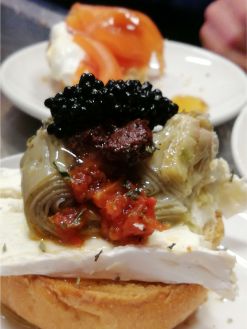
Last update on 2024-04-25 / Affiliate links / Images from Amazon Product Advertising API

